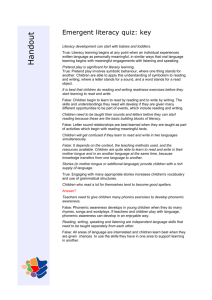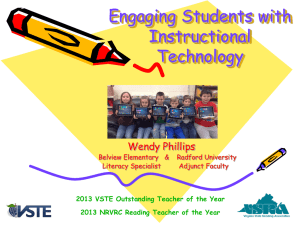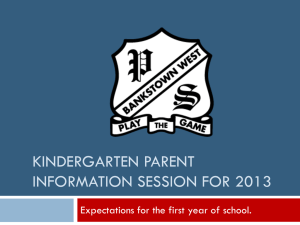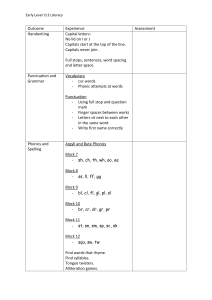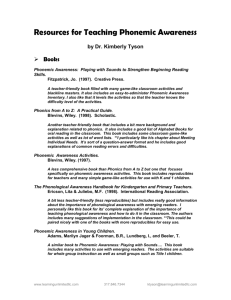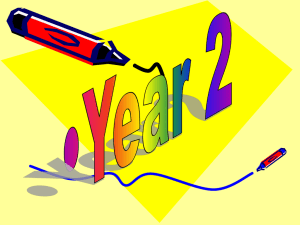Functional Literacy in a Life Skills Curriculum
advertisement
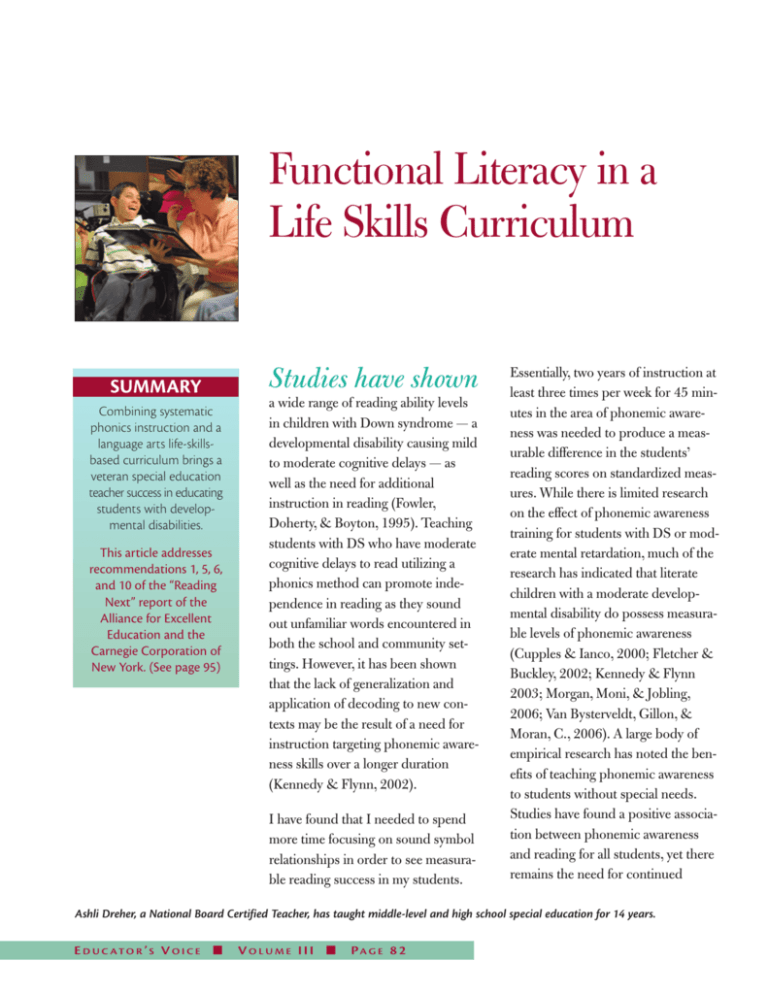
Functional Literacy in a Life Skills Curriculum Studies have shown SUMMARY Combining systematic phonics instruction and a language arts life-skillsbased curriculum brings a veteran special education teacher success in educating students with developmental disabilities. This article addresses recommendations 1, 5, 6, and 10 of the “Reading Next” report of the Alliance for Excellent Education and the Carnegie Corporation of New York. (See page 95) a wide range of reading ability levels in children with Down syndrome — a developmental disability causing mild to moderate cognitive delays — as well as the need for additional instruction in reading (Fowler, Doherty, & Boyton, 1995). Teaching students with DS who have moderate cognitive delays to read utilizing a phonics method can promote independence in reading as they sound out unfamiliar words encountered in both the school and community settings. However, it has been shown that the lack of generalization and application of decoding to new contexts may be the result of a need for instruction targeting phonemic awareness skills over a longer duration (Kennedy & Flynn, 2002). I have found that I needed to spend more time focusing on sound symbol relationships in order to see measurable reading success in my students. Essentially, two years of instruction at least three times per week for 45 minutes in the area of phonemic awareness was needed to produce a measurable difference in the students’ reading scores on standardized measures. While there is limited research on the effect of phonemic awareness training for students with DS or moderate mental retardation, much of the research has indicated that literate children with a moderate developmental disability do possess measurable levels of phonemic awareness (Cupples & Ianco, 2000; Fletcher & Buckley, 2002; Kennedy & Flynn 2003; Morgan, Moni, & Jobling, 2006; Van Bysterveldt, Gillon, & Moran, C., 2006). A large body of empirical research has noted the benefits of teaching phonemic awareness to students without special needs. Studies have found a positive association between phonemic awareness and reading for all students, yet there remains the need for continued Ashli Dreher, a National Board Certified Teacher, has taught middle-level and high school special education for 14 years. E D U C AT O R ’ S V O I C E n V O L U M E I I I n PA G E 8 2 Ashli Dreher, Lewiston-Porter United Teachers research in the area of teaching phonics to students with DS and its relationship to their acquisition of literacy (Fowler, Doherty, & Boynton, 1995; Buckley, Bird, & Byrne, 1996; Cupples & Ianco, 2000; Conners, 1992; Fletcher & Buckley, 2002; Joseph & Seery, 2004). Although all individuals with Down syndrome experience cognitive delays, the delays range from mild to moderate in severity. This article will focus on instructional strategies for students with a moderate developmental delay. Teaching students with moderate developmental disabilities to read was a challenging task to look forward to when I began the 2003 school year. As I met my first group of eager freshman in Lewiston-Porter High School’s new 8:1:1 (eight students, one teacher, and one teacher aide or teaching assistant) life skills classroom, all but one of the students could read little more than their own name when they walked into school on the first day of classes. During the next six school years, however, five of the six students with Down syndrome and moderate mental retardation learned to read and write at the first-through-third-grade levels. A combined approach utilizing systematic phonics instruction and a language arts life-skills-based curriculum provided the students with the understanding of the sounds in our language as well as common sight words they would see in restaurant-related jobs, at home when cooking in the kitchen, or on packages at the grocery store. The phonemic awareness instruction occurred three times each week as whole group lessons, and instruction was differentiated based on a student’s ability to recognize letters and sounds. The different ability groups were instructed simultaneously. PowerPoint slides shown in Table 1 were developed to target Level 1 and Level 2 during the lesson, and teacher aides provided one-to-one assistance to students working in Level 1. Level 1 of the phonics program involved constructing three-letter words with short vowel sounds, such as cat, cot, cut, tip, etc. Level 2 students construct threeand four-letter words with short vowel sounds, digraph blends (ship, shop, chip, chop), and blends (flop, flat, flip) as well as words with welded sounds (sink, sank, sunk). Level 3 students begin to learn how to sound out multisyllabic words containing short vowel METHODOLOGY Do I have to teach them how to read? Every middle and high school has some students who have not yet mastered the basics of reading. They may be English language learners, students with cognitive disabilities, or students with brain injuries. These students may receive support in a resource room, through Academic Intervention Services, or in special education. But when they are in a regular classroom they may need assistance with vocabulary. While the strategies outlined here appear to be for elementaryage beginning readers, you will find students at this reading level in many content classrooms. continued on following page E D U C AT O R ’ S V O I C E n Functional Literacy in a Life Skills Curriculum METHODOLOGY Table 1: Slide show segment for teaching phonics in our classroom, along with the teacher instructions for the class: Slide 1 Slide 2 Slide 3 cat sunk Slide 4 sounds. A differentiated approach to phonics instruction can be applied to any elementary classroom or instructional situation where you are teaching students with varying phonemic awareness abilities. Students may use plastic alphabet letters or a dry erase board and markers to construct the words they will be asked to read and write during the lesson. n Show a blank slide (Slide 1) and tell Table 2: METHODOLOGY Lesson Format for 45-Minute Class Table 2: Lesson format for 45-minute class: 5 minutes Teacher reviews the letters, digraphs, welded sounds using a chant: “a-apple-ah,” “b-bell-bah,” etc. 20 minutes Students are asked to construct 10 words using plastic alphabet letters. Using PowerPoint slides, the teacher can point to each word and sound them out with the class. 10 minutes Teacher and students read the list of words as a whole group. Students each have a turn reading the list of words aloud. 10 minutes Teacher keeps the list of words on the screen, reading one at a time. Students write the word read next to each number on their paper. students in the first group to make the word “cat.” The teacher aides will sound out the word until students have spelled it correctly. Instruct students in the second group to make the work “sunk.” Sound out the word until students have made the word. n Move on to Slide 2 and ask the class to sound out the word. The teacher should point to each letter as the sound of the letter is made. n Show Slide 3 and ask the students to sound out the word as you point to each letter and say its sound. n Project blank Slide 4 and have students complete the second group of words. Repeat this procedure until all 10 words have been constructed. A chart indicating the lesson time frame and activities is included in Table 2. After students have constructed their words, each student will read the group of words aloud. A PowerPoint slide should be shown with all of the Level 2 words listed. The teacher will point to each word and assist students as they E D U C AT O R ’ S V O I C E n V O L U M E I I I n PA G E 8 4 read the list of words. Students then complete a brief assessment as the teacher reads the words in random order and students copy the correct word on to their paper from the projected list of words. If students have more than two words incorrect, the lesson should be repeated for mastery. Level 1 students should work one-onone with an assistant, if needed, and have their words written on Post-it notes to read from. When they take their test, they will be read a random word from the lesson. They will be asked to select the correct Post-it note containing the word and place it next to the number on their test paper. Then, the student will write the word on their paper. It is important for students with developmental disabilities to recognize functional words within the community; however students also need instruction utilizing a direct approach in phonemic awareness that can be generalized within their community and classrooms. In addition to explicit phonemic awareness instruction, a balanced literacy program that includes the use of materials already in place in the school environment, such as trade books and magazines, will afford students a rich literary experience grounded in everyday practice as they move from a logographic stage of reading to include the alphabetic and orthographic stages of reading development. With these thoughts in mind I began a search for a life-skills-based curriculum that would enable students to learn to utilize the oven, microwave, and other small appliances in our classroom kitchen. A program called “Cooking to Learn 2 — Integrated Reading and Writing Activities” by Coxson and Nilson was added to our classroom instructional routine. Directions and comprehension questions are included for each lesson, both with and without illustrations. For students in class who struggle with reading, the worksheets are scanned and used with Read and Write Gold, a computer software program that will highlight and read each word aloud for the students. Table 3 illustrates the differentiation provided by this “hands-on” method to increase functional sight word awareness. A differentiated approach to phonics instruction can be applied to any elementary classroom or instructional situation where you are teaching students with varying phonemic awareness abilities. Table 3: Food and Cooking Items to Make a Morning Surprise Each section of the lesson includes picture cues for students. Table 4 outlines specific steps in the instructional process involved in completing the recipe-based lesson. One page contains illustrations of each direction for emergent readers; the other page has no illustrations for students with a basic reading skill level. continued on following page E D U C AT O R ’ S V O I C E n V O L U M E I I I n PA G E 8 5 Functional Literacy in a Life Skills Curriculum METHODOLOGY Table 4: Step-by-Step Directions for Making Macaroni and Cheese Table 3: At the end of each cooking lesson, there are comprehension questions for students to complete, a cloze activity, as well as a reflective thinking writing assignment, which asks students to recap what they did in class as shown in Table 5. The comprehension questions, as illustrated in Table 6 are also differentiated. Emergent writers may give a one- or two-word answer, which is scribed by a teacher and traced by the student. Other students give shortened answers, which the teacher should say aloud in a complete sentence and write on an overhead so that students can see examples of how writers leave spaces between words, write in a leftto-right pattern, and read the information they are writing. Food and Cooking Items to Make a Morning Surprise METHODOLOGY Table 4: Step-by-Step directions for making Macaroni and Cheese Table 5: Sample Cloze Activity and Comprehension Questions Table 6: Differentiated Comprehension Question Activities In all aspects of the instructional program, teaching assistants have been an integral part of the success our students experienced in the acquisition of literacy. The TAs attend trainings with the teacher to learn important skills implemented in the classroom, and the Lewiston-Porter School District has provided the SchoolRelated Professional in the high E D U C AT O R ’ S V O I C E n V O L U M E I I I n PA G E 8 6 school with laptops and computer training as well. This has proven extremely helpful in my ability to use assistive technology that the TAs must be familiar with if emergent readers are to be active participants in the phonics and cooking lessons. A close-knit, professional learning community where TAs and special education teachers share ideas and input is a necessary condition to begin collaborating on instructional strategies and implementation. A lack of reading opportunities that fails to immerse the child in a literacyfilled environment and explicit reading instruction that does not continue beyond basic skills in reading perpetuate the marginalization of individuals with disabilities. There are major implications for developing a sound, research-based literacy program for students with developmental disabilities. Students will have the ability to be readers and function more independently in the community if they can sound out and comprehend unfamiliar words. Employment opportunities will increase, and the students’ abilities to manage their lives without assistance will improve as well. METHODOLOGY Table 5: Sample Cloze Activity and Comprehension Questions METHODOLOGY Table 6: Differentiated Comprehension Question Activities Students in the 8:1:1 class at Lewiston-Porter High School took great pride in reading selections for their parents at our classroom dinners and selecting books to read for pleasure, both at school and home. continued on following page E D U C AT O R ’ S V O I C E n V O L U M E I I I n PA G E 8 7 Functional Literacy in a Life Skills Curriculum Generalizing the skill of decoding and learning to think about the messages that words and sentences are conveying will create additional opportunities for independence for special-needs students with moderate developmental disabilities. Witnessing the joy of the mothers and fathers of students who, until high school, had not heard their children read independently, is something I will never forget. Not only were students able to read directions for life skills purposes such as cooking, they enjoyed reading stories, notes from their parents, and birthday invitations from classmates. Generalizing the skill of decoding and learning to think about the messages that words and sentences convey creates additional opportunities for independence for special-needs students. REFERENCES Adams, M. J., Allington, R., Chaney, J., Goodman, Y., Kapinus, B., McGee, L., Richgels, D., Schwartz, S., Shannon, P., Smitten, B., Williams, J. (1991). Beginning to read: A critique by literary professionals and a response by Marilyn Adams. The Reading Teacher 44(6), 371-395. Buckley, S., Bird, G., and Byrne, A. (1996). The practical and theoretical significance of teaching literacy skills to children with Down syndrome. In J.A. Rondal, J. Perera, L. Nadel, & A. Comblain (Eds), Down syndrome: psychological, psychobiological, and socio-educational perspectives (pp. 119-128). London: Whurr. Coxson, L & Nilson, C. (2001). Cooking to Learn 2: Integrated Reading and Writing Activities. PCI Educational Publishing. Cupples, L. & Ianco, T. (2000). Phonological awareness and oral reading skills in children with Down syndrome. Journal of Speech, Language, and Hearing Research 43(3), 595-608. Fletcher, H. & Buckley, S. (2002). Phonological awareness of children with Down syndrome. Down Syndrome Research and Practice 8(1), 11-18. Fowler, A.E., Doherty, B.J., & Boynton, L. (1995). The basis of reading skill in young adults with Down syndrome. In L. Nadel & D. Rosenthal (Eds.), Down syndrome: Living and learning in the community (pp. 182-196). New York: Wiley-Liss. E D U C AT O R ’ S V O I C E n V O L U M E I I I n PA G E 8 8 Green, B. & Kostogriz, A. (2002). Learning difficulties and the New Literacy Studies: A socially critical perspective. In J. Soler, J. Wearmouth & G. Reid (Eds.), Contextualizing difficulties in literacy development: Exploring politics, culture, ethnicity and ethics (pp. 102-114), London: RoutledgeFalmer. Joseph, L., & Seery, M. (2004). Where is the phonics? A review of the literature on the use of phonetic analysis with students with mental retardation. Remedial and Special Education, 25(2), 88-94. Kennedy, E.J. & Flynn, M.C. (2003). Training phonological awareness skills in children with Down syndrome. Research in Developmental Disabilities, 24(1), 44-57. Liberman, I.Y., Shankweiler, D., & Liberman, A.M. (1989). The alphabetic principle and learning to read. Reprinted from “Phonology and reading disability: Solving the reading puzzle.” International Academy for Research in Learning Disabilities Monograph Series. Morgan, M., Moni, K., & Jobling, M.A. (2006). Code-breaker: Developing phonics with a young adult with an intellectual disability. Journal of Adolescent & Adult Literacy 50(1), 52-65. Thomas, G, & Loxley, A. (2001). Thinking about learning failure, especially in reading. In G. Thomas & A. Loxley, Deconstructing special education and constructing inclusion (pp. 65-75). Buckingham, UK: Open University Press. Van Bysterveldt, A.K., Gillon, G.T., & Moran, C. (2006). Enhancing phonological awareness and letter knowledge in preschool children with Down syndrome. International Journal of Disability, Development, and Education 53(3). E D U C AT O R ’ S V O I C E n V O L U M E I I I n PA G E 8 9
